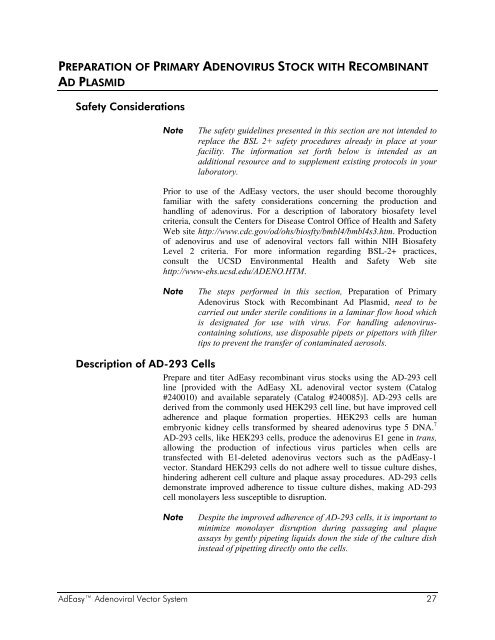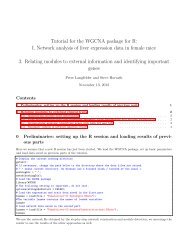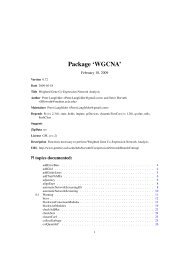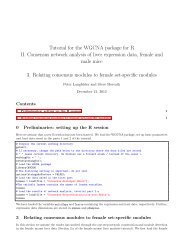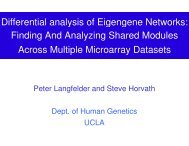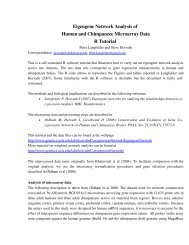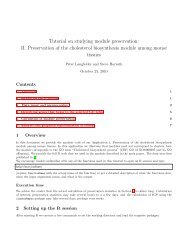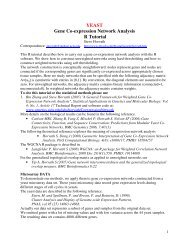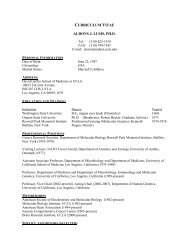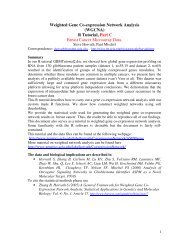Manual: AdEasy Adenoviral Vector System - UCLA Human Genetics
Manual: AdEasy Adenoviral Vector System - UCLA Human Genetics
Manual: AdEasy Adenoviral Vector System - UCLA Human Genetics
You also want an ePaper? Increase the reach of your titles
YUMPU automatically turns print PDFs into web optimized ePapers that Google loves.
PREPARATION OF PRIMARY ADENOVIRUS STOCK WITH RECOMBINANT<br />
AD PLASMID<br />
Safety Considerations<br />
Note<br />
The safety guidelines presented in this section are not intended to<br />
replace the BSL 2+ safety procedures already in place at your<br />
facility. The information set forth below is intended as an<br />
additional resource and to supplement existing protocols in your<br />
laboratory.<br />
Prior to use of the <strong>AdEasy</strong> vectors, the user should become thoroughly<br />
familiar with the safety considerations concerning the production and<br />
handling of adenovirus. For a description of laboratory biosafety level<br />
criteria, consult the Centers for Disease Control Office of Health and Safety<br />
Web site http://www.cdc.gov/od/ohs/biosfty/bmbl4/bmbl4s3.htm. Production<br />
of adenovirus and use of adenoviral vectors fall within NIH Biosafety<br />
Level 2 criteria. For more information regarding BSL-2+ practices,<br />
consult the UCSD Environmental Health and Safety Web site<br />
http://www-ehs.ucsd.edu/ADENO.HTM.<br />
Note<br />
The steps performed in this section, Preparation of Primary<br />
Adenovirus Stock with Recombinant Ad Plasmid, need to be<br />
carried out under sterile conditions in a laminar flow hood which<br />
is designated for use with virus. For handling adenoviruscontaining<br />
solutions, use disposable pipets or pipettors with filter<br />
tips to prevent the transfer of contaminated aerosols.<br />
Description of AD-293 Cells<br />
Prepare and titer <strong>AdEasy</strong> recombinant virus stocks using the AD-293 cell<br />
line [provided with the <strong>AdEasy</strong> XL adenoviral vector system (Catalog<br />
#240010) and available separately (Catalog #240085)]. AD-293 cells are<br />
derived from the commonly used HEK293 cell line, but have improved cell<br />
adherence and plaque formation properties. HEK293 cells are human<br />
embryonic kidney cells transformed by sheared adenovirus type 5 DNA. 7<br />
AD-293 cells, like HEK293 cells, produce the adenovirus E1 gene in trans,<br />
allowing the production of infectious virus particles when cells are<br />
transfected with E1-deleted adenovirus vectors such as the p<strong>AdEasy</strong>-1<br />
vector. Standard HEK293 cells do not adhere well to tissue culture dishes,<br />
hindering adherent cell culture and plaque assay procedures. AD-293 cells<br />
demonstrate improved adherence to tissue culture dishes, making AD-293<br />
cell monolayers less susceptible to disruption.<br />
Note<br />
Despite the improved adherence of AD-293 cells, it is important to<br />
minimize monolayer disruption during passaging and plaque<br />
assays by gently pipeting liquids down the side of the culture dish<br />
instead of pipetting directly onto the cells.<br />
<strong>AdEasy</strong> <strong>Adenoviral</strong> <strong>Vector</strong> <strong>System</strong> 27


